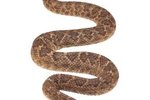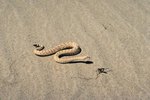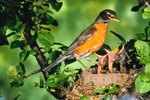Mambas are feared through much of Africa for their speed, aggressiveness and deadly venomous bites. Their genus name, Dendroaspis, means "tree snake." Most mambas live up to their name and spend the majority of their time in trees, but not the most deadly species, the black mamba. These snakes prefer to hunt on the ground.
Green Mambas
Both the eastern green mamba and the western green mamba are arboreal, meaning they spend most of their lives in trees. They might occasionally travel by land to reach new hunting grounds or chase highly appetizing prey, but these snakes prefer the protection of the trees. Green mambas eat other animals that live in the trees, such as birds, lizards and squirrels, which helps keep them from needing to venture onto the ground often. Their venom is highly poisonous, but they don't encounter people often.
Green Mamba Nests
Green mambas can lay 10 to 15 eggs at a time, and the mama mamba needs a safe place to house her babies. Instead of feeling vulnerable in a ground lair, she nests among leaves and other vegetation in a hole in a hollow tree. The baby snakes hatch in the tree. They have venom when they hatch, which means they can begin hunting immediately in their chosen arboreal habitat without needing time on the ground first.
Black Mambas
Black mambas are among the most venomous snakes in the world. When bitten by a black mamba, a person usually dies within 15 to 20 minutes unless he receives the antivenin immediately. Unlike green mambas, black mambas don't live in trees. They spend the majority of their time on the ground, where they use their speed -- up to nearly 13 mph -- to catch prey. A black mamba is an excellent tree climber when he wants to be, such as when he's seeking out a bird or rodent nest, but he typically returns to the ground after his meal.
Black Mamba Nests
Like green mambas, black mambas create lairs that they return to each evening, and females lay their eggs in the lairs. Black mambas occasionally make lairs in low sections of hollow trees, but it's more common for them to burrow into abandoned insect mounds or in rock crevices. Because they are faster than the green mambas, black mambas prefer to stay on or close to the ground for rapid escape from predators or to move quickly on unsuspecting prey.





